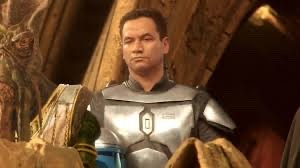#< tag for SWS news not directly from their twitter
Text
John FuhNaff is releasing an exclusive interview with Steel Wool Studios on Friday, May 31st!
#not real sws#fnaf#five nights at freddys#five nights at freddy's#steel wool studios#not sws twt#< tag for SWS news not directly from their twitter
55 notes
·
View notes
Note
Hey, I kind of have a request and I'm sorry if I'm being inconvenient or something, it's just that you're one of the most knowledgeable person (people?? I'm sorry, I'm not a english speaker) on this Force forsaken fandom and actually knows what being a Jedi means and this new episode has made all the Jedi haters rise from hell so... I was wondering if you had some sources of GL talking about how the Jedi were actually the victims of all that happened in the prequels (can't believe I'm asking for a source about how genocide victims are, in fact, victims, this fandom is killing me) and how they were, in fact, right and that their beliefs and values weren't the reason why they were murdered.
I'm sorry for asking this, I know you must also be frustrated about all the Attachment Discourse™ and the Jedi hate and misinterpretation all over the internet now, I'm just really upset having to deal with this and now people are even shitting on Golden Boy Luke "Never Did Anything Wrong In His Life" Skywalker and it almost feels like I'm on another dimension because I thought everybody loved him but now people are blaming him and his beliefs for what happened to his Jedi Order and I'm @($+2!#!37#8@;2!
So, if it won't trouble you, please, could you give me some power juice (source) so I can at least have something beyond my awful explanation (I suck at explaining things) to rub on the face of whoever comes to my bubble to talk shit about my kids?
Oh, this is going to be a tough one, because I'm not sure there's a smoking gun of George Lucas specifically saying they were victims because, like, I'm pretty sure it was so blisteringly obvious that he never felt he had to talk about it.
Like, if you're asking, "How would I show the deaths of people who kind of brought it on themselves? I know! THEIR BABIES ARE MURDERED WHEN CUTELY ASKING FOR HELP. Yes, literal BABY MURDER is the way to show the Jedi were kinda bad actually." I'm not sure what else there is even to say.
Or even just, "If [x] group of people had just done [x], they wouldn't have been genocided out of existence!" is--what do you even say to that?
It's more in the way Lucas talks about how the philosophies of his movies are ones that directly align with the Jedi teachings, it's more in the way that Lucas talks about how the fall of the Republic was at the feet of the Senate, it's more in the way Lucas talks about how Anakin's fall was because he was attached to things and didn't want to accept Jedi philosophy, rather than directly saying, "The Jedi were victims of this." I mean, I can't even think of any examples where he talks about Order 66 specifically at all?
I do have a george lucas tag, which includes a lot of quotes that might help you get started (and meta by a lot of really thoughtful, smart people), or else just hit up @david-talks-sw's blog who is an absolute rock star at collecting together quotes and organizing them into excellent meta (this one is a great place to start if you haven't seen it yet), which is about all I can think to offer.
If anyone else has any other thoughts on this, I'd love to hear them, especially on anon's request about how the Jedi were victims/commentary on the deaths of the Jedi!
(Also, I know SW fandom is a hell pit, but come over here and join us, we've been yelling a lot and there's plenty to keep you occupied while you ignore the tags and possibly the entirety of Twitter for awhile. 😂)
314 notes
·
View notes
Note
is tbb racist
Hi anon.
Uhm. Please forgive me here, I am most likely not the best person to be asking this, since I’m delirious on pain meds the majority of the time at the moment, but I will do my best to answer truthfully and appropriately.
As I don’t know the nature of this question (as I have a lot of non-star wars people who follow me), I will address that directly, TBB doesn’t show active themes of racism in the writing, we don’t see any of the characters being prejudice against others due to the colour of their skin/race. So the show themes itself are not, in my opinion at least. (Please let me know if I missed anything in that regard) Essentially here I’m saying the characters themselves are not racist.
However
There are a lot of issues surrounding the animation of not only the bad batch, but the clone wars too. (It’s a lot more prominent in the bad batch due to characters like Tech, Crosshair and Omega.)
The characters, who are supposed to be clones of Jango Fett (see below.) are predominantly whitewashed. Jango Fett’s actor is Temuera Morrison (an incredible actor btw.) who is both a New Zealander and descends of the Māori/Polynesian New Zealand settlers (I think I have that right.) however, as I’ve stated below, so many of these clones don’t mirror these racial heritages, and as a result, are whitewashed and erasing his culture from the SW media.
Like I said, I am not as well versed in the topic as some might be, but I completely support the “UnWhiteWashTheBadBatch” movement. It is ridiculous we are forced to believe that these people-






-are supposed to be clones of this man.



That in itself is inherently racist.
Alongside this, there have also been multiple accounts of problematic themes and unjust animation throughout the show, regarding prioritising POC as imperial ‘villains’, and other characters such as Fennec Shand, Saw Gerrera, the Martez Sisters, and other clones such as Howzer and Rex.
Below I’m going to tag some helpful links that really helped to enlighten me and get me involved in the subject, and if anybody else happens to have anything extra to add to aide anybody who might find this post, please feel free to reblog/reply.
I actually took part in this form/questionnaire when it was released! Very insightful!
I hope this post was insightful enough to remind everybody to never look past these issues. They are extremely important and should never be silenced. The fact we have such amazing people fighting this cause is a gift, if only we now had animators/directors/people on the tbb team willing to listen.
Awareness is always appreciated.
#the bad batch#star wars#hunter tbb#omega tbb#tech tbb#wrecker tbb#Crosshair tbb#clone force 99#tbb#echo tbb#arc trooper echo#sergeant hunter#unwhitewashtcw#unwhitewashtbb#unwhitewash star wars#unwhitewash the bad batch#unwhitewash the clones#racism in Star Wars#fennec Shand#galactic empire#captain rex#captain howzer#saw gerrera#rafa martez#trace martez#the martez sisters
48 notes
·
View notes
Text
Answering some questions* from this post, made by @hellamella77

1. What kind of system are you? (Describe this in any way you like. No need to use -genic or popular terms if you don't want to)
We describe our system as endogenic and wtfgenic. It's a large and fictive-heavy system
2. How many of you are there?
Almost 300, and we constantly gain new members
3. How long have you known about your plurality?
As of posting this, only 29 days
4. What kind of spaces/communities do you/did you hang out in? (Both plural-relevant and non-plural-relevant spaces are valid answers, past and present)
Mainly fandom related spaces, though we don't do much other than check tags for art. The exception is the genshin community, we're a bit more involved there. And the endo community here on Tumblr. We've also hung out in the drag community a bit (tumblr, twitter, and insta)
5. Had you heard of DID/OSDD/DDNOS before you became plural/discovered your plurality?
Yes, though we had only heard negative things from DID systems
6. Do you have a wonderland/innerworld? If so, what do you call it, and what are some things that you and your system members do there?
Yes, and we call it innerworld or headspace. It's mainly for headmates to live/hang out in. It's a giant apartment/house with many rooms and other spaces for everyone to live in and do as they please
7. What do you call your system members?
We use the terms headmates and members
9. What are some of the best things about being plural?
Always having someone to talk to/keep you company. Learning about other people's interests/hobbies and maybe trying some of those out myself
10. What are some of the not-so-great things about being plural? (Any answer is valid- nothing is too minor or too major to be an answer to this question.)
Not sure if this counts, but as the host, I'm worried about forgetting that my headmates are individuals with wants and needs just like me. I'm worried about not being able to fulfill those needs and wants, especially being disabled mentally and physically.
11. Do you have a spiritual or psychological view of your plurality?
Kind of spiritual I guess?? I believe some of our headmates are from past lives and/or are soulmates/twin flames
12. Do you ever experience "switching" or "posession" or any sort of change in who controls the body? If so, what do you call it, how easy/difficult is it, and what is it like? Were you always able to do this, or did you have to learn how over time?
I believe we do switch sometimes, but it can be really hard to tell when it happens. Sometimes it's easy to tell when someone else is fronting because it will feel like an out of body experience, I can feel and see that my body is typing something but I can also tell that it's not me doing it. I can also sometimes tell when an emotion I'm feeling isn't my own. To my knowledge, we've always done this
13. How do you and your system mates relate to each other? (Are you friends, family, romantically involved, caretakers, etc.)
A lot of us are in polyam relationships with each other. A lot of the kids and younger headmates view some members as older siblings or parental figures
14. Have you come out to anybody in real life/in a singlet space about your plurality? How did it go?
I've never said anything to anyone directly, but I did mention it on my main blog. No one has said anything though
16. What are you and your system members interested in?
Anime, manga, and video games are a pretty common interest. Some of our other interests are: horror, fashion (different types of lolita, goth, emo/scene, drag), witchcraft, plants, art, weebcore, collecting things (crystals, figures, books), y2k/nostalgiacore, music, youtubers (marki/plier, unus annus, igp).
We also enjoy mythology, urban legends, and cryptids (without cultural appropriation)
18. What are your music tastes? Movies? Favorite colors? Animals? List any other favorites as well
Music: Vocaloid, bmth, emo bands like sws/ptv/mcr/adtr, Nathan Sharp, we also generally enjoy Japanese and Korean artists.
Movies: horror/thriller and some comedy
Colours: Black, red, blue, purple
Animals: Lion, panda, literally any feline, rodents
Shows: K-drama/thrillers (Alice in Borderland, Sweet Home, Squid Game)
Video games: Overwatch, Genshin Impact, Minecraft, DMC, FNAF
19. Does your system have a host/original? If so, what do you call them? Explain what role they play in your system
Yes, it's me, Vinny! And we don't really have roles. I just provide the body and try to keep us alive by doing basic things like eating and bathing
20. Do any system members have notable relationships outside of the system? Explain them!
Not yet. It doesn't seem like anyone has an interest in romantic relationships outside of our system, though no one seems opposed to platonic relationships with outsiders
21. If you haven't been plural for your entire life/haven't known about your plurality until later in life: what was life like before plurality compared to life now?
The only difference is that I'm aware of more things, like mood swings/sudden interests in things/and some dissociation being the influence of headmates
23. Is there anything you'd like to say to the plural community at large?
Love each other and don't worry about how other systems exist, we're all going through life as best we can. Intra-community fighting never helps anyone.
Also shout out to the endos/non-traumagenics/accepting traumagenics for helping me realize all the different ways you can be a system. And that it's not a horrible thing you have to suffer through (since that was my only impression beforehand).
*some questions were left out because we couldn't answer/didn't have an answer
Banner credit
2 notes
·
View notes
Text
How to Write Meta Descriptions in a Constantly Changing World (AKA Google Giveth, Google Taketh Away)
Posted by Dr-Pete
Summary: As of mid-May 2018, Google has reverted back to shorter display snippets. Our data suggests these changes are widespread and that most meta descriptions are being cut off in the previous range of about 155–160 characters.
Back in December, Google made a significant shift in how they displayed search snippets, with our research showing many snippets over 300 characters. Over the weekend, they seem to have rolled back that change (Danny Sullivan partially confirmed this on Twitter on May 14). Besides the obvious question — What are the new limits? — it may leave you wondering how to cope when the rules keep changing. None of us have a crystal ball, but I'm going to attempt to answer both questions based on what we know today.
Lies, dirty lies, and statistics...
I pulled all available search snippets from the MozCast 10K (page-1 Google results for 10,000 keywords), since that's a data set we collect daily and that has a rich history. There were 89,383 display snippets across that data set on the morning of May 15.
I could tell you that, across the entire data set, the minimum length was 6 characters, the maximum was 386, and the mean was about 159. That's not very useful, for a couple of reasons. First, telling you to write meta descriptions between 6–386 characters isn't exactly helpful advice. Second, we're dealing with a lot of extremes. For example, here's a snippet on a search for "USMC":
Marine Corps Community Services may be a wonderful organization, but I'm sorry to report that their meta description is, in fact, "apple" (Google appends the period out of, I assume, desperation). Here's a snippet for a search on the department store "Younkers":
Putting aside their serious multi-brand confusion, I think we can all agree that "BER Meta TAG1" is not optimal. If these cases teach you anything, it's only about what not to do. What about on the opposite extreme? Here's a snippet with 386 characters, from a search for "non-compete agreement":
Notice the "Jump to Exceptions" and links at the beginning. Those have been added by Google, so it's tough to say what counts against the character count and what doesn't. Here's one without those add-ons that clocks in at 370 characters, from a search for "the Hunger Games books":
So, we know that longer snippets do still exist. Note, though, that both of these snippets come from Wikipedia, which is an exception to many SEO rules. Are these long descriptions only fringe cases? Looking at the mean (or even the median, in this case) doesn't really tell us.
The big picture, part 1
Sometimes, you have to let the data try to speak for itself, with a minimum of coaxing. Let's look at all of the snippets that were cut off (ending in "...") and remove video results (we know from previous research that these skew a bit shorter). This leaves 42,863 snippets (just under half of our data set). Here's a graph of all of the cut-off lengths, gathered into 25 character bins (0–25, 26–50, etc.):
This looks very different from our data back in December, and is clearly clustered in the 150–175 character range. We see a few Google display snippets cut off after the 300+ range, but those are dwarfed by the shorter cut-offs.
The big picture, part 2
Obviously, there's a lot happening in that 125–175 character range, so let's zoom in and look at just the middle portion of the frequency distribution, broken up into smaller, 5-character buckets:
We can see pretty clearly that the bulk of cut-offs are happening in the 145–165 character range. Before December, our previous guidelines for meta descriptions were to keep them below 155 characters, so it appears that Google has more-or-less reverted to the old rules.
Keep in mind that Google uses proportional fonts, so there is no exact character limit. Some people have hypothesized a pixel-width limit, like with title tags, but I've found that more difficult to pin down with multi-line snippets (the situation gets even weirder on mobile results). Practically, it's also difficult to write to a pixel limit. The data suggests that 155 characters is a reasonable approximation.
To the Wayback Machine... ?!
Should we just go back to a 155 character cut-off? If you've already written longer meta descriptions, should you scrap that work and start over? The simple truth is that none of us know what's going to happen next week. The way I see it, we have four viable options:
(1) Let Google handle it
Some sites don't have meta descriptions at all. Wikipedia happens to be one of them. Now, Google's understanding of Wikipedia's content is much deeper than most sites (thanks, in part, to Wikidata), but many sites do fare fine without the tag. If your choice is to either write bad, repetitive tags or leave them blank, then I'd say leave them blank and let Google sort it out.
(2) Let the ... fall where it may
You could just write to the length you think is ideal for any given page (within reason), and if the snippets get cut off, don't worry about it. Maybe the ellipsis (...) adds intrigue. I'm half-joking, but the reality is that a cut-off isn't the kiss of death. A good description should entice people to want to read more.
(3) Chop everything at 155 characters
You could go back and mercilessly hack all of your hard work back to 155 characters. I think this is generally going to be time badly spent and may result in even worse search snippets. If you want to rewrite shorter Meta Descriptions for your most important pages, that's perfectly reasonable, but keep in mind that some results are still showing longer snippets and this situation will continue to evolve.
(4) Write length-adaptive descriptions
Is it possible to write a description that works well at both lengths? I think it is, with some care and planning. I wouldn't necessarily recommend this for every single page, but maybe there is a way to have our cake and eat at least half of it, too...
The 150/150 approach
I've been a bit obsessed with the "inverted pyramid" style of writing lately. This is a journalistic style where you start with the lead or summary of your main point and then break that down into the details, data, and context. While this approach is well suited to the web, its origins come from layout limitations in print. You never knew when your editor would have to cut your article short to fit the available space, so the inverted pyramid style helped guarantee that the most important part would usually be spared.
What if we took this approach to meta descriptions? In other words, why not write a 150-character "lead" that summarizes the page, and then add 150 characters of useful but less essential detail (when adding that detail makes sense and provides value)? The 150/150 isn't a magic number — you could even do 100/100 or 100/200. The key is to make sure that the text before the cut can stand on its own.
Think of it a bit like an ad, with two separate lines of copy. Let's take this blog post:
Line 1 (145 chars.)
In December, we reported that Google increased search snippets to over 300 characters. Unfortunately, it looks like the rules have changed again.
Line 2 (122 chars.)
According to our new research (May 2018), the limit is back to 155-160 characters. How should SEOs adapt to these changes?
Line 1 has the short version of the story and hopefully lets searchers know they're heading down the right path. Line 2 dives into a few details and gives away just enough data (hopefully) to be intriguing. If Google uses the longer description, it should work nicely, but if they don't, we shouldn't be any worse for wear.
Should you even bother?
Is this worth the effort? I think writing effective descriptions that engage search visitors is still very important, in theory (and that this indirectly impacts even ranking), but you may find you can write perfectly well within a 155-character limit. We also have to face the reality that Google seems to be rewriting more and more descriptions. This is difficult to measure, as many rewrites are partial, but there's no guarantee that your meta description will be used as written.
Is there any way to tell when a longer snippet (>300 characters) will still be used? Some SEOs have hypothesized a link between longer snippets and featured snippets at the top of the page. In our overall data set, 13.3% of all SERPs had featured snippets. If we look at just SERPs with a maximum display snippet length of 160 characters (i.e. no result was longer than 160 characters), the featured snippet occurrence was 11.4%. If we look at SERPs with at least one display snippet over 300 characters, featured snippets occurred at a rate of 41.8%. While that second data set is fairly small, it is a striking difference. There does seem to be some connection between Google's ability to extract answers in the form of featured snippets and their ability or willingness to display longer search snippets. In many cases, though, these longer snippets are rewrites or taken directly from the page, so even then there's no guarantee that Google will use your longer meta description.
For now, it appears that the 155-character guideline is back in play. If you've already increased some of your meta descriptions, I don't think there's any reason to panic. It might make sense to rewrite overly-long descriptions on critical pages, especially if the cut-offs are leading to bad results. If you do choose to rewrite some of them, consider the 150/150 approach — at least then you'll be a bit more future-proofed.
Sign up for The Moz Top 10, a semimonthly mailer updating you on the top ten hottest pieces of SEO news, tips, and rad links uncovered by the Moz team. Think of it as your exclusive digest of stuff you don't have time to hunt down but want to read!
from Blogger https://ift.tt/2IoPQnB
via SW Unlimited
0 notes
Text
Beaverton Staffing Agency Shares How to Find Work Using Social Media

Most businesses have evolved from the traditional ways of hiring, which has caused job seekers to conduct their job search in different ways as well. Even with all of the digital options available, some businesses and employment agencies in Beaverton, OR still prefer job seekers to visit the establishment to fill out an application personally, so that human interaction isn't lost in the process. Today, businesses have expanded their accessibility to tech-savvy job seekers by making it easy for applicants to fill out applications online and sometimes even doing skype interviews rather than an office visit. In addition to these changes, social media has now become a popular, useful tool for job seekers and businesses alike. Here are a few ways to find work by using your own social media profiles.
Facebook
Social media has made a huge impact on employment. Businesses and temp agencies in Beaverton can post job listings specifically in the jobs tab on their page for users to look through. Not only are the jobs easy to read through, but you can also apply for these jobs directly on Facebook and message your resume to the business as well. Before applying to any jobs make sure to have your work experience visible and remove any questionable pictures or posts that you uploaded or were tagged in.
Twitter
Twitter is another website to search jobs easily and know what kind of employees the businesses are looking to hire. The best way to find jobs on Twitter is to follow companies that you are interested in and that match your degree, skills, and qualifications. Hashtags are the main useful feature on Twitter that can help you find work or help businesses find you. Direct your posts towards the type of job you want to obtain and use the hashtags, and you may actually get in touch with some business owners. If you are specifically using your Twitter account for job hunting, avoid posting anything that would be considered drama or too much of your personal life. A good option is to always keep public accounts more professional. If you feel confident enough, message the business to see about applying for the job or sending in your resume.
LinkedIn
LinkedIn is the more professional platform of social media for job efforts. The way that you set up your LinkedIn profile will have a lot to do with who you get in contact with. You want to first make sure that all of your information is up-to-date with job experiences, education, skills, qualifications, certifications, and anything else that may be directed towards your vocation. Update your image to a professional photograph and be sure to tag any of your skills that you may have. Anytime you learn a new skill or gain new certifications, update your information right away that way the information precisely matches your resume. You can not only contact businesses that have LinkedIn profiles; but when you have tags about your profession, the business or a Beaverton staffing agency will be able to find you and contact you through LinkedIn for a possible interview.
Social media platforms are so prevalent today that most businesses are moving towards posting most of their job openings onto these platforms such as Twitter, Facebook, LinkedIn, and even the ones not discussed such as Instagram and Snapchat. Businesses and even a well-known job agency in Beaverton, OR are using social media more and more so keep your profiles updated and active for a successful online job search.
Locally owned and operated, Express Employment Professionals in Tigard, OR is your Full-Service employment agency. We continually exceed our customers' expectations by providing expert advice, timely resources, and training. We help companies in our community while helping job seekers find employment. Together, we help people succeed in the Tigard and Beaverton areas.
Express Employment Professionals of Tigard, OR
10115 SW Nimbus Ave #500
Tigard, OR 97223
(503) 624-2001
https://www.expresspros.com/TigardOR
#Staffing Agency#Employment Agencies#Temp Agencies#Job Agency#Employment Agency#Tigard#Beaverton#Oregon
0 notes
Text
Tangential Content Earns More Links and Social Shares in Boring Industries [New Research]
Posted by kerryjones
Many companies still don’t see the benefit of creating content that isn’t directly about their products or brand. But unless you have a universally interesting brand, you’ll be hard-pressed to attract much of an audience if all you do is publish brand-centric content.
Content marketing is meant to solve this dilemma. By offering genuinely useful content to your target customers, rather than selling to them, you earn their attention and over time gain their trust.
And yet, I find myself explaining the value of non-branded content all too often. I frequently hear grumblings from fellow marketers that clients and bosses refuse to stray from sales-focused content. I see companies publishing what are essentially advertorials and calling it content marketing.
In addition to turning off customers, branded content can be extremely challenging for building links or earning PR mentions. If you’ve ever done outreach for branded content, you’ve probably gotten a lot of pushback from the editors and writers you’ve pitched. Why? Most publishers bristle at content that feels like a brand endorsement pretending not to be a brand endorsement (and expect you to pay big bucks for a sponsored content or native advertising spot).
Fortunately, there’s a type of content that can earn your target customers’ attention, build high-quality links, and increase brand awareness...
Tangential content: The cure for a boring niche
At Fractl, we refer to content on a topic that’s related to (but not directly about) the brand that created it as "tangential content."
Some hypothetical examples of tangential content would be:
A pool installation company creating content about summer safety tips and barbeque recipes.
A luggage retailer publishing country-specific travel guides.
An auto insurance broker offering car maintenance advice.
While there’s a time for branded content further down the sales funnel, tangential content might be right for you if you want to:
Reach a wide audience and gain top-of-funnel awareness. Not a lot of raving fans in your “boring” brand niche? Tangential topics can get you in front of the masses.
Target a greater number of publishers during outreach to increase your link building and PR mention potential. Tangential topics work well for outreach because you can expand your pool of publishers (larger niches vs. a small niche with only a few dedicated sites).
Create more emotional content that resonates with your audience. In an analysis of more than 300 client campaigns, we found the content that received more than 200 media mentions was more likely than low-performing campaigns to have a strong emotional hook. If your brand niche doesn’t naturally tug on the heartstrings, tangential content is one way to create an emotional reaction.
Build a more diverse content library and not be limited to creating content around one topic. If you’ve maxed out on publishing content about your niche, broadening your content repertoire to tangential topics can reinvigorate your content strategy (and your motivation).
Comparison of tangential vs. on-brand content performance
In our experience at Fractl, tangential content has been highly effective for link building campaigns, especially in narrow client niches that lack broad appeal. While we’ve assumed this is true based on our observations, we now have the data to back up our assumption.
We recently categorized 835 Fractl client campaigns as either “tangential” or “on-brand,” then compared the average number of pickups (links and press mentions) and number of social shares for each group. Our hunch was right: The tangential campaigns earned 30% more media mentions and 77% more social shares on average than the brand-focused campaigns.
So what exactly does a tangential campaign look like? Below are some real examples of our client campaigns that illustrate how tangential topics can yield stellar results.
Most Hateful/Most Politically Correct Places
Client niche: Apartment listing site
Campaign topic: Which states and cities use the most prejudiced/racist language based on geo-tagged Twitter data
Results: 67,000+ social shares and 620 media pickups, including features on CNET, Slate, Business Insider, AOL, Yahoo, Mic, The Daily Beast, and Adweek
Why it worked
After a string of on-brand campaigns for this client yielded average results, we knew capitalizing on a hot-button, current issue would attract tons of attention. This topic still ties back into the client’s main objective of helping people find a home since the community and location of that home are important factors in one’s decisions. Check out the full case study of this campaign for more insights into why it was successful.
Most Instagrammed Locations
Client niche: Bus fare comparison and booking tool
Campaign topic: Points of interest where people post the most Instagram photos in North America
Results: 40,000+ social shares and more than 300 pickups, including TIME, NBC News, Business Insider, Today, Yahoo!, AOL, Fast Company, and The Daily Mail
Why it worked
Our client’s niche, bus travel, had a limited audience, so we chose a topic that was of interest to anyone who enjoys traveling, regardless of the mode of transportation they use to get there. By incorporating data from a popular social network and using an idea with a strong geographic focus, we could target a lot of different groups — the campaign appealed to travel enthusiasts, Instagram users, and regional and city news outlets (including TV stations). For more details about our thought process behind this idea, see the campaign case study.
Most Attractive NFL Players and Teams
Client niche: Sports apparel retailer
Campaign topic: Survey that rates the most attractive NFL players
Results: 45,000+ social shares and 247 media pickups, including CBS Sports, USA Today, Fox Sports, and NFL.com
Why it worked
Since diehard fans want to show off that their favorite player is the best, even if it’s just in the looks department, we were confident this lighthearted campaign would pique fan interest. But fans weren’t the only ones hitting the share button — the campaign also grabbed the attention of the featured teams and players, with many sharing on their social media profiles, which helped drive exposure.
On-brand content works best in certain verticals
Tangential content isn’t always necessary for earning top-of-funnel awareness. So, how do you know if your brand-centric topics will garner lots of interest? A few things to consider:
Is your brand topic interesting or useful to the general population?
Are there multiple publishers that specifically cover your niche? Do these publishers have large readerships?
Are you already publishing on-brand content that is achieving your goals/expectations?
We’ve seen several industry verticals perform very well using branded content. When we broke down our campaign data by vertical, we found our top performing on-brand campaign topics were technology, drugs and alcohol, and marketing.
Some examples of our successful on-brand campaign topics include:
“Growth of SaaS” for a B2B software comparison website
“Influencers on Instagram” for an influencer marketplace
“Global Drug Treatment Trends” for an addiction recovery client
“The Tech Job Network” for a tech career website
Coming up with tangential content ideas
Once you free yourself from only brainstorming brand-centric ideas, you might find it easy to dream up tangential concepts. If you need a little help, here are a few tips to get you started:
Review your buyer personas.
In order to know which tangential topics to choose, you need to understand your target audience’s interests and where your niche intersects with those interests. The best way to find this information? Buyer personas. If you don’t already have detailed buyer personas built out, Mike King’s epic Moz post from a few years ago remains the bible on personas in my opinion.
Find topics your audience cares about with Facebook Audience Insights.
Using its arsenal of user data, this Facebook ads tool gives you a peek into the interests and lifestyles of your target audience. These insights can supplement and inform your buyer personas. See the incredibly actionable post “How to Create Buyer Personas on a Budget Using Facebook Audience Insights” for more help with leveraging this tool.
Consider how trending news topics are tangential to your brand.
Pay attention to themes that keep popping up in the news and how your brand relates back to these stories (this is how the most racist/bigoted states and cities campaign I mentioned earlier in this post came to be). Also anticipate seasonal or event-based topics that are tangential to your brand. For example, a tire manufacturer may want to create content on protecting your car from flooding and storm damage during hurricane season.
Test tangential concepts on social media.
Not sure if a tangential topic will go over well? Before moving forward with a big content initiative, test it out by sharing content related to the topic on your brand’s social media accounts. Does it get a good reaction? Pro tip: spend a little bit of money promoting these as sponsored posts to ensure they get in front of your followers.
Have you had success creating content outside of your brand niche? I’d love to hear about your tangential content examples and the results you achieved, please share in the comments!
Sign up for The Moz Top 10, a semimonthly mailer updating you on the top ten hottest pieces of SEO news, tips, and rad links uncovered by the Moz team. Think of it as your exclusive digest of stuff you don't have time to hunt down but want to read!
from Blogger http://ift.tt/2yM4wef
via SW Unlimited
0 notes